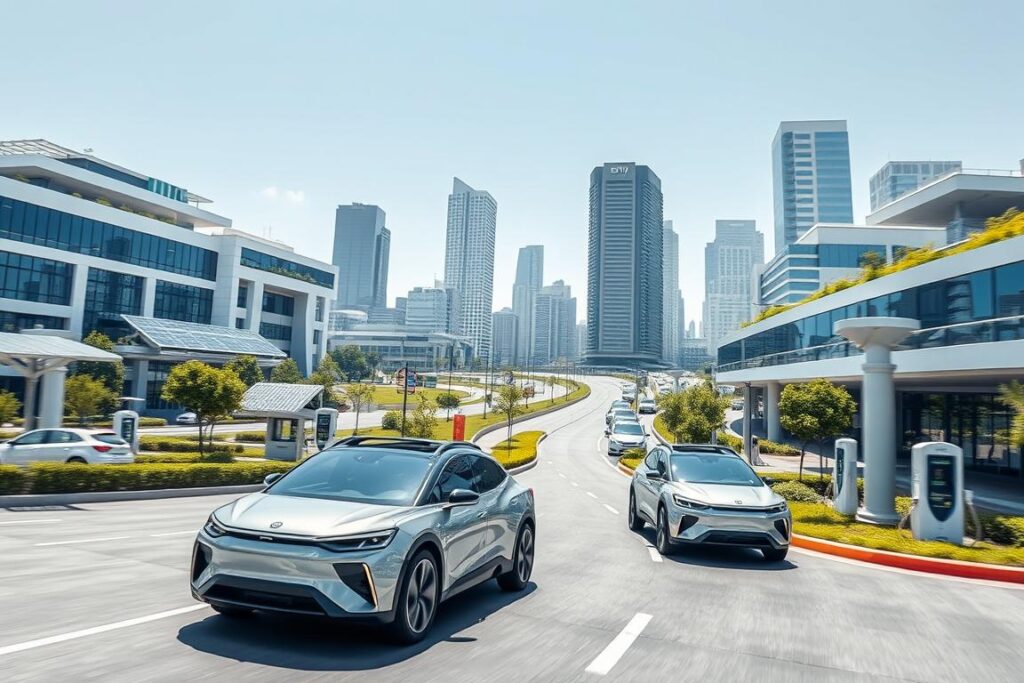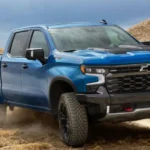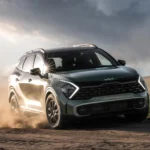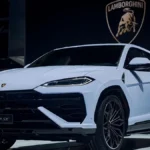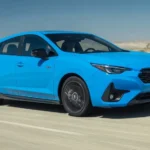BYD started in 1995 and has grown a lot. It’s known for electronics, cars, green energy, and trains. With over 27 years of experience, BYD is a top name in clean energy solutions.
The company is big, with over 30 industrial parks on 6 continents. BYD USA, its American branch, opened in Los Angeles in 2011. It makes electric buses and trucks, showing its dedication to green travel in the US.
Key Takeaways
- BYD is a leading technology company with expertise in electronics, automotives, renewable energy, and rail transit.
- BYD USA, the North American subsidiary, was established in 2011 to manufacture zero-emission buses and trucks.
- BYD has a global presence with over 30 industrial parks across 6 continents, focusing on sustainable energy solutions.
- BYD is committed to advancing zero-emission mobility in the United States through its innovative electric vehicle offerings.
- The company’s focus on renewable energy and sustainability aligns with the growing demand for eco-friendly transportation options in America.
The Evolution of BYD: From Battery Maker to Global EV Leader
BYD, a Chinese company, has changed a lot in 20 years. It started as a battery maker and now leads the electric vehicle (EV) market. It uses its knowledge of lithium-ion batteries and energy storage to succeed.
Origins as a Battery Technology Company
BYD began in 1995 making rechargeable batteries. It focused on lithium-ion battery technology. This early success helped it grow into the EV industry.
Transition to Electric Vehicle Manufacturing
About 20 years ago, BYD started making electric vehicles. It used its battery knowledge to make efficient EVs. This move helped BYD stand out in the EV market.
Warren Buffett’s Strategic Investment
In 2008, Warren Buffett’s Berkshire Hathaway bought a big part of BYD. This showed strong belief in BYD’s future. It helped BYD grow in the EV market.
Now, BYD is a top EV brand worldwide. It offers many electric cars, buses, and commercial vehicles. Its journey shows its innovative spirit and commitment to green transport.
BYD USA: Current Market Presence and Operations
BYD USA, the American arm of the Chinese electric vehicle giant, is making waves in the U.S. and Canada. It hasn’t brought its passenger cars to these markets yet. But, BYD has made a mark in public transportation and commercial trucks.
So far, BYD has sold more than 700 electric vehicles in the U.S. and Canada. These sales are mainly in public transportation buses and heavy-duty commercial trucks. The company’s website lists details for the Han EV sedan, hinting at plans to enter the passenger car market soon.
BYD faces hurdles in Western markets but uses its strengths to its advantage. It has its own battery tech, makes parts in-house, and gets support from the Chinese government. Focusing on public transportation and commercial trucks has helped BYD establish a presence in North America.
| Key Highlights | Data |
|---|---|
| Electric Vehicles Sold in U.S. and Canada | Over 700 |
| Primary Focus Segments | Municipal Buses, Heavy-Duty Trucks |
| Potential Future Expansion | Passenger Car Models (e.g., Han EV Sedan) |
BYD’s growth in the U.S. and Canada has been slow but steady. Its innovative tech and focus on public transportation and commercial trucks make it a strong contender in the North American EV market.
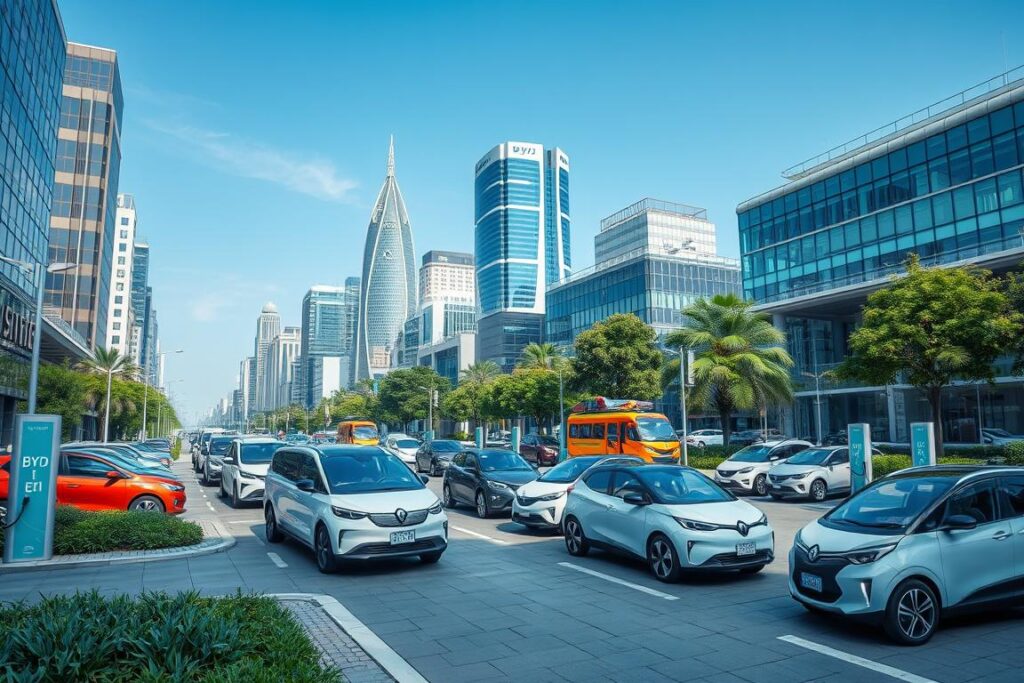
Breaking Industry Records: BYD’s Global Sales Achievement
In the fast world of electric vehicles, BYD USA is making waves. The Chinese automaker recently beat Tesla in global sales in the fourth quarter of 2023. This achievement made BYD the world’s top maker of new-energy vehicles for the whole year.
Surpassing Tesla in Q4 2023
BYD showed its market strength by selling 526,000 battery-electric vehicles in the last quarter of 2023. This was the first time they outdid Tesla. Their sales were impressive, with over 3 million NEVs sold, including 1.6 million battery-only models.
Annual Sales Performance Statistics
BYD’s 2023 sales were outstanding. They sold 3,024,417 vehicles, beating their goal of 3 million. This was a 61.9% increase from the year before. It also made BYD a top 10 car seller globally for the first time.
Market Share Analysis
BYD’s sales growth caught everyone’s attention. Their exports jumped by 334.2% to 242,765 units, reaching over 70 countries. This growth, along with strong domestic sales, made BYD a leader in the electric vehicles and passenger cars market.
“BYD’s exponential sales growth saw a 61.9% surge from the previous year, reaching the global top 10 of car sales for the first time in 2023.”
Commercial Vehicle Success in North America
BYD’s North American arm has led the way in commercial vehicles. It has sold over 700 electric buses and trucks in the U.S. and Canada. This shows its skill in green solutions for public transport and logistics.
The North America Electric Commercial Vehicle Market is expected to hit USD 247.21 billion by 2031. It will grow at a compound annual growth rate (CAGR) of 14.48% from 2024 to 2031. This growth is due to tech advancements, wider uses, and more people wanting green options. It’s a great chance for BYD to grow in North America.
BYD’s success in commercial vehicles is a stepping stone to the passenger market. As it keeps innovating, it’s set to be a big name in electric vehicles in North America.
| Top Manufacturers in the North America Electric Commercial Vehicle Market |
|---|
| BYD Company Limited, Daimler AG, Tesla Inc., Volkswagen Group, Ford Motor Company, General Motors Company, Volvo Group, Rivian Automotive LLC, Tata Motors Limited, and Arrival Ltd. |
BYD is known for its top-notch public transportation and trucks. It has a strong base in North America. As green driving becomes more popular, BYD is ready to seize new chances and shape the electric transport future.
“BYD sold 3 million vehicles worldwide last year, showing its big operation.”
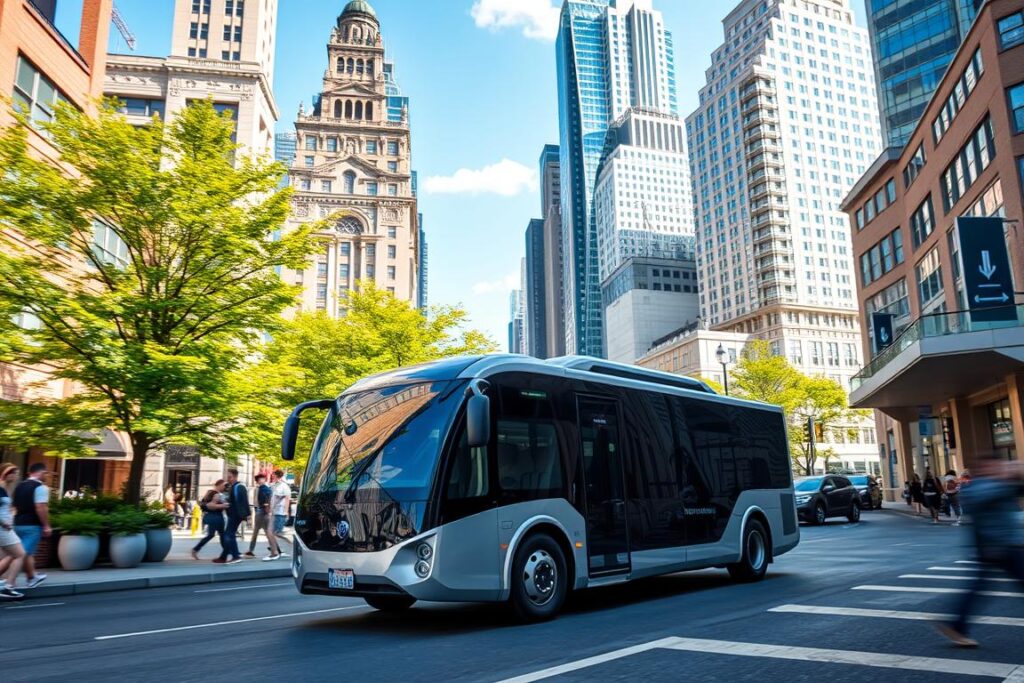
Innovation in Battery Technology and Manufacturing
BYD started as a top maker of lithium-ion batteries. This gave it a big lead in making electric vehicles (EVs). BYD’s own battery making lets it keep prices low, beating other car makers.
Proprietary Battery Systems
BYD’s success comes from its Blade Battery tech. It uses Lithium Iron Phosphate (LFP) for safety. The Blade Battery is safer than others, with a high decomposition temperature.
Its design lets more cells fit in, making cars more efficient. This makes the Blade Battery stand out.
Cost Advantages in Production
The Blade Battery is cheaper to make, thanks to LFP. This means electric cars are more affordable. BYD offers cars at many price points, even under $10,000.
BYD’s focus on battery tech and making its own batteries has led to big wins. It made its 5 millionth EV in August. Its battery know-how and cost savings will shape the EV future.
| Battery Type | Heat Release (J/g) | Decomposition Temperature (°C) |
|---|---|---|
| Lithium Iron Phosphate (LFP) | ~200 | ~270 |
| Lithium Nickel Manganese Cobalt Oxide (NMC) | ~600 | N/A |
| Lithium Nickel Cobalt Aluminum Oxide (NCA) | ~900 | N/A |
The table shows BYD’s Blade Battery is safer. It uses LFP, which is safer than NMC and NCA. The Blade Battery has less heat release and a higher decomposition temperature, proving its safety.
Strategic Expansion into Mexico and Beyond
BYD USA is becoming a top electric vehicle brand in America. The company is now looking to grow beyond its home market. In 2023, BYD launched its Dolphin EV model in Mexico, marking the start of its North American journey.
BYD is planning to open an assembly plant in Mexico. This move could help the company reach the U.S. market more easily. The North American Free Trade Agreement (NAFTA) and the United States-Mexico-Canada Agreement (USMCA) might offer benefits.
BYD’s goals go even further. The company has also introduced the Dolphin model in Japan. This shows BYD’s aim to grow its electric vehicle presence worldwide. It’s a big step towards making transportation more sustainable.
BYD USA’s move into Mexico and other countries is setting it up for success. With a focus on innovation and the environment, BYD is ready to shape the future of electric vehicles and passenger cars.
“BYD’s strategic expansion into Mexico and beyond is a testament to the company’s vision for sustainable mobility on a global scale.”
Challenges and Opportunities in the U.S. Market
As byd usa looks to grow in the U.S. electric vehicle (EV) market, it faces many challenges and opportunities. The U.S. government’s policies and tariffs are hurdles for the company’s entry strategy.
Regulatory Hurdles
New tariffs on Chinese-made EVs, batteries, and other products have been introduced. These tariffs could reach 100% by August 2024. They aim to protect U.S. EV makers but are obstacles for byd usa.
U.S. rules on EV subsidies also require a lot of content and assembly in the U.S. This makes byd usa‘s market entry strategy more complicated.
Trade Relations Impact
The tensions between the U.S. and China affect byd usa‘s plans to expand in the U.S. market. Geopolitical factors and trade relations create uncertainty for the company.
Tariff Considerations
The U.S. has a 25% tariff on Chinese vehicles arriving at ports. This tariff affects byd usa‘s pricing and competitiveness. Future tariff increases pose a big challenge for the company.
Despite these challenges, byd usa sees great opportunities in the U.S. market. The company is working on innovative strategies to succeed. Its focus on affordable and sustainable mobility could be key to its success in America.
Competitive Pricing Strategy and Market Positioning
BYD, a leading Chinese electric vehicle (EV) brand, is known for its affordable passenger cars. In China, BYD electric cars start at just $10,000 USD. This makes them very popular. BYD’s own battery production helps keep costs low, making it a strong competitor.
In other countries, BYD’s prices are higher. For example, the BYD Atto 3 costs $19,283 in China but $42,789 in Germany. The Dolphin electric car is $37,439 in Europe but $16,524 in China. This shows big price differences between China and other countries.
BYD’s pricing strategy helps it make good profits abroad. It also lets the company invest in new technology. But, tariffs and trade rules could affect its prices in the electric vehicles U.S. market.
| Model | China Price | Germany Price | Price Difference |
|---|---|---|---|
| BYD Atto 3 | $19,283 | $42,789 | $23,506 |
| BYD Dolphin | $16,524 | $37,439 | $20,915 |
BYD’s prices make its electric vehicles competitive worldwide. This helps the brand compete with big names like European and American car makers. BYD’s pricing strategy shows its goal to be a major player in the global EV market.
“BYD’s ability to offer affordable electric vehicles, coupled with its in-house battery production, has been a key driver of its success in the Chinese market.”
Sustainability Initiatives and Environmental Impact
At BYD, sustainability is at the heart of what they do. They’re not just making electric vehicles. They’re also working on renewable energy solutions to cut down carbon emissions and help the planet. BYD is leading the way in sustainable technologies, from solar panels to energy storage systems.
Zero-Emission Solutions
BYD is all about zero-emission solutions, not just cars. They’re also working on advanced energy storage systems. This lets them use solar panels in homes, businesses, and cities. This approach helps reduce environmental impact in many areas, making our world more sustainable.
Renewable Energy Integration
- BYD controls its production process, reducing reliance on others.
- They have recycling programs to get valuable materials from old batteries, supporting a circular economy.
- BYD focuses on efficient and high-quality manufacturing, using the latest technology.
BYD’s dedication to sustainability is real, not just a slogan. They’re using renewable energy and eco-friendly practices to lead the way to a cleaner future.
“BYD’s ‘green dream of all mankind’ aims to help cities establish and maintain zero emissions and zero pollution through electrifying modes of transportation.”
As we face climate change, BYD’s commitment to sustainability is setting a new standard. They’re blending electric vehicles, renewable energy, and recycling to create a better tomorrow.
Conclusion
BYD has become a global leader in electric vehicles and renewable energy. It faces challenges in the U.S. car market but is growing in commercial vehicles and Mexico. This shows its strong growth in North America.
BYD’s battery tech, prices, and focus on green energy make it a key player in electric cars and clean energy. Its sales and market share are growing fast. This means BYD will keep changing the car industry and help make transportation greener.
As BYD grows in North America, it will need to deal with rules and trade issues. But BYD’s history of innovation and meeting different market needs is promising. It’s ready to meet the U.S. and other countries’ growing need for electric cars and clean energy.

